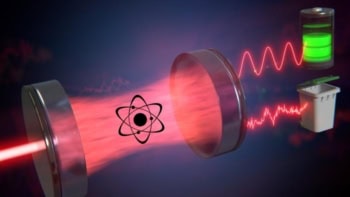For several decades physicists have been intrigued by the idea of quantum friction — that two objects moving past each other experience a friction–like lateral force that arises from quantum fluctuations in the vacuum.
Several independent groups of physicists have previously calculated that quantum friction could arise from the Casimir force between two plates — when those plates move relative to one another. There is also some indirect experimental evidence that such a lateral force exists.
Now, however, researchers in the UK having performed detailed calculations, which they claim show that there is no lateral force and that quantum friction therefore doesn’t exist.
In 1948 Dutch physicist Hendrik Casimir worked out that two uncharged, perfectly conducting metal plates placed in a vacuum should be attracted to one another. This force arises from the fact that, according to quantum mechanics, the energy of an electromagnetic field in a vacuum is not zero but continuously fluctuates around a certain mean value, known as the “zero–point energy”. Casimir showed that the radiation pressure of the field outside the plates will tend to be slightly greater than that between the plates and therefore the plates will experience an attractive force.
Reflection leads to friction?
Evgeny Lifshitz generalized Casimir’s prediction for real materials in 1956, and for the last thirty years researchers have also tried to calculate what happens to the Casimir force when the plates move relative to one another with uniform velocity. The electromagnetic waves, or modes, that exist between the plates bounce back and forth off the plates and this reflection will be affected by the motion of the plates.
Physicists agree that this changing reflection alters the now familiar perpendicular component of the Casimir force, but a number of researchers have also calculated that there should be a lateral force between the plates, a quantum-mechanical friction that could potentially be of great interest to engineers trying to improve the performance of ultra-small mechanical devices.
For example, John Pendry of Imperial College in London has calculated that differences between the Doppler shift of two modes reflecting off moving plates in different directions can lead to a frictional force if the reflectivities of the surfaces depend on frequency.
However, Thomas Philbin of the University of St Andrews says that trying to calculate this modified Casimir force is extremely difficult and that previous efforts to do so have not been satisfactory because they have used approximations. Working with his colleague at St Andrews, Ulf Leonhardt, he has used Lifshitz’s theory to carry out what he claims is an exact calculation and shows that there is no lateral force (arXiv:0810.3750v2, to appear in New Journal of Physics).
Thought experiment
To illustrate the feasibility of this result in very general terms, Philbin describes a thought experiment using what is known as a “bi-anisotropic medium”. This is a material in which electric fields or magnetic fields applied separately will induce both magnetic dipoles and electric dipoles in the material, and that such a medium at rest is the equivalent of a certain kind of non bi-anisotropic material in motion.
Philbin then considers building caterpillar tracks from this bi-anisotropic medium and imagines what would happen when the tracks are placed on some other arbitrary medium — as far as electromagnetism is concerned, he says, the tracks are then moving. He goes on to argue that if quantum friction existed these tracks would experience a lateral force and therefore start to actually move, and that they would continue to move indefinitely, thereby performing the impossible — extracting unlimited energy from the quantum vacuum.
“If quantum friction existed one could think about trying to manipulate and engineer it, as experimentalists are now doing with the Casimir force between non-moving objects,” says Philbin. “But since it doesn’t exist this possibility disappears.”
Pendry, however, defends his work, maintaining that he derived his result using two completely different lines of argument, and that these were also backed up by independent research. In addition, he says that quantum-frictional effects have been observed experimentally, albeit indirectly, in resistance measurements of a device consisting of two field-effect transistors placed one above the other and separated by a very small insulating gap.



